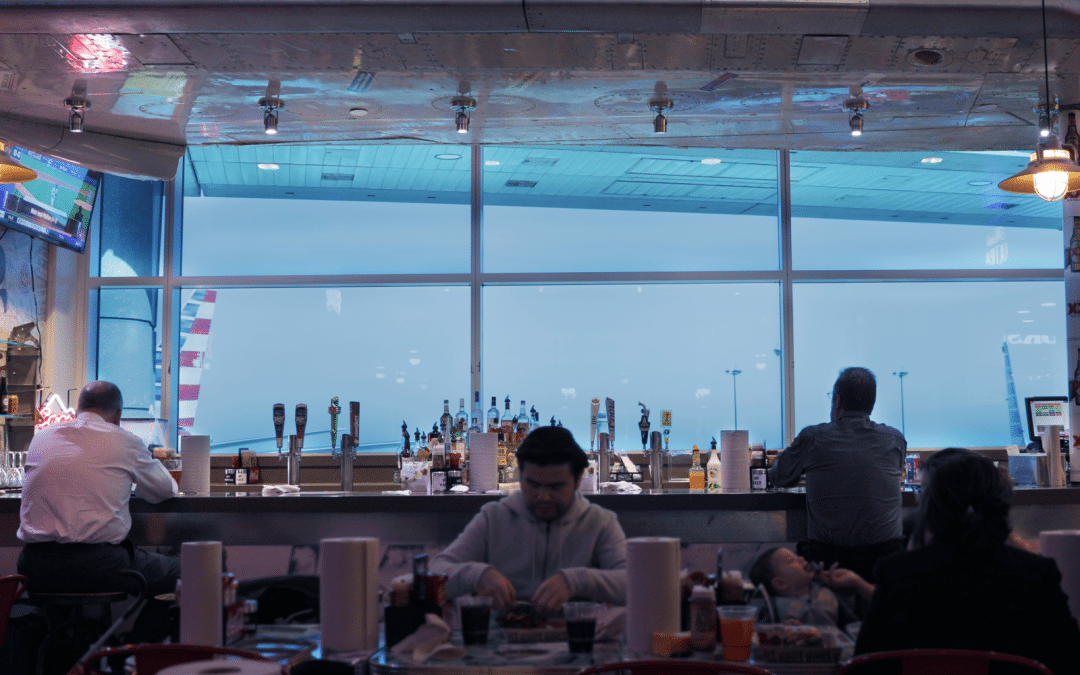A survey by Dr. Alan Hedge of Cornell University in conjunction with Dallas/Fort Worth International Airport (DFW) found that terminal windows outfitted with smart glass, specifically View Dynamic Glass, vastly improve passenger comfort by reducing glare and other unintended factors. Using View Dynamic Glass, versus using conventional glass, resulted in an 83 percent increase in passenger dwell time at his or her preferred gate seat and a 102 percent increase in concession spending. The study found that the use of View Dynamic Glass correlated to higher overall revenues and reduced operational costs for the terminals where it is used.
“Think of [View Dynamic Glass] as transition lenses for the building,” says Brandon Tinianov, vice president of industry strategy for View Dynamic Glass. “But unlike transition lenses, they don’t lag when you walk inside or outside. It does it all actively, and it does it all intelligently.”
Smart glass helps create a more comfortable seating environment for travelers and airport employees by reducing glare and unwanted heat inside the terminal area. The glass has been installed in several airports, including Boston Logan International Airport (BOS), Charlotte Douglas International Airport (CLT), San Francisco International Airport (SFO) and Seattle-Tacoma International Airport (SEA), and more airports are looking to install View Dynamic Glass in the future.
Because the use of the glass can reduce other expenses, such as those of additional motorized blinds or air conditioning, View has found the installation of its glass to be cost neutral. “The glass is more expensive [than conventional glass], but at a total system basis, it ends up being cost equivalent or very similar,” says Tinianov. “At SFO, again the glass is more expensive, but it’s replacing or it eliminated the need for electromechanical blinds or some other shading treatment, and it allowed them to actually downsize the systems enough to offset any additional cost. So it was cost neutral or cost beneficial there.”
The glass also helps airports make their facilities more green.
“DFW is the world’s largest carbon-neutral airport, and we are constantly evaluating new technologies and solutions throughout the airport to identify improvements for customer experience and sustainability,” says Sean Donohue, CEO at DFW Airport. “The results of this study confirm that dynamic glass can reduce cooling costs and support DFW’s commitment to minimize our carbon footprint. We were very pleased to see the positive effect on the customer experience and how the glass changed customer behavior with less glare and cooler temperatures.”
Importantly for concessionaires, the installation of smart glass can translate to increased spending. For example, dynamic glass was installed in the bar area of the Twisted Root restaurant at DFW, and the restaurant saw a 102 percent increase in alcohol sales against the previous six months.
“Airports face a unique challenge of adding passenger capacity while maximizing the efficiency of the terminals,” says Tinianov. “Using smart technologies to reduce stress and improve comfort is key. A beneficial result is that happier, comfortable passengers also spend more. Our recent research study validates that the reduced glare and surface temperatures provided by View Dynamic Glass have a noticeable and measurable impact on passenger comfort. These features will allow U.S. airport hubs, like those we are working with today, to compete with the world’s top airports.”
The study was conducted by Dr. Alan Hedge, professor in the department of design and environmental analysis at Cornell. For the study, dynamic glass was installed at two locations in DFW, in Gate A28 and in the bar of a nearby restaurant. Both areas are oriented east and experience significant morning sun and heat. The study compared results with a control area, Gate A25, which remained outfitted with conventional glass. Data was collected from more than 30 flights using video footage, and surveys were conducted with more than 500 passengers.







